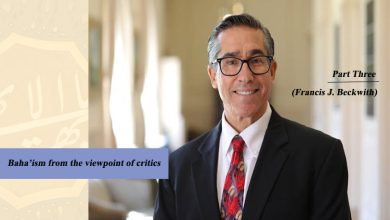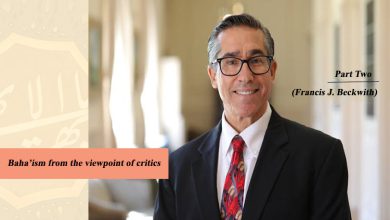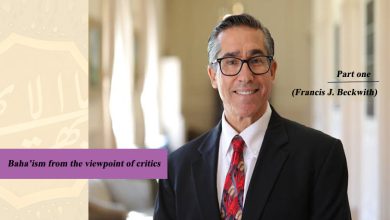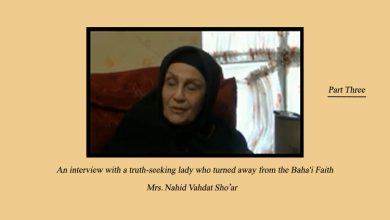
Pursuant to dissolution of the Local Spiritual Assembly of the Baha’is of Los Angeles, in 1986, Dr. Juan r. Cole, a then intellectual Baha’i scholar, and Michigan University Professor of the Islamic and M.E. studies, criticized the kind of interference of the U.S. NSA in that case. Some of the NSA members, who could not bear any criticize, attacked him in an article. The response of Cole to that article contains very useful sociological information about the USA Baha’i community and its leading group, in general.
As the U.S. Baha’i community is usually considered as the symbol and cradle of the Baha’i Administration, and on the other hand, the Baha’i authorities do not publish any informative material that would help to acknowledge the vision, organization and structure, and financial and teaching activities, so we found it a good fortune to publish this article.
For a better understanding of the article, we have chosen sub-titles for the text.
*******
My thanks to Mike McMullen for his comments on the article, and for his kind words on some of its strengths. I have found his own work on the Atlanta Baha’i community very useful. However, the purpose of this exchange is surely somewhat un-Baha’i-like task of addressing our differences.
First of all, I should signal to academic readers why I think my article might be problematic for conservative Baha’is. The Baha’i culture is utopian, and Baha’is often wish to present the inner workings of their community life as perfect. They see their administrative order as an alternative to the politics of the corrupt old world order, which is under the control of powerful individuals and marred by individualist selfishness. That some of these same forces are at work within their own administration is therefore a proposition they find difficult to entertain.
The Baha’i Utopian Ideals & Culture
Moreover, a great deal of work goes into preserving the utopian point of view. In my experience, Baha’i governance structures are deliberately kept opaque. Conservative Baha’is are very skeptical that anything serious can even be known about their governance processes outside official pronouncements. Baha’is are discouraged from speaking of community governance issues except in carefully controlled venues. Baha’i authorities, who surround themselves with an aura of divine guidance, keep believers in line by appealing to the welfare and unity of the community, and if these appeals fail then implicit or explicit threats of shunning are invoked.
Non-Baha’is are not allowed to attend the nineteen day feast, the main business meeting of the local community, or the national convention held in April each year in Wilmette. (Among religious bodies of any size in the U.S., the annual Bahai national convention is the only one from which journalists are systematically excluded). Such a closed political culture makes the gathering of quantitative information extremely difficult, if not impossible. Two friends of mine in the Los Angeles community who did attempt to conduct a poll some years ago were instructed to desist by the local spiritual assembly (LSA), and I frankly do not believe such research would be allowed. That is, the Baha’is would be ordered by their authorities not to cooperate with it.
The lack of quantitative evidence is, in short, hardly my fault, but would bedevil anyone who took up this sort of subject. Indeed, as I made clear, the very publication of articles about the incident was also forbidden by Robert Henderson, so asking for quantitative data in addition seems unrealistic. On the other hand, historians very seldom have the sort of complete set of quantitative information available to contemporary, synchronic disciplines like sociology, and we have developed techniques to compensate for this. I do not think it terribly controversial, for instance, to suggest that when only two hundred out of 1200 local Baha’is showed up to see the national spiritual assembly (NSA) members in 1988, this poor attendance was a sign of disgruntlement with that body, given much higher attendance rates at other events.
Given the deliberate opaqueness of Baha’i culture and contemporary history, what is remarkable is that I gained access to dozens of documents on this issue from various key players, which survived in the Dialogue magazine archives. I therefore, have what is, from a historian’s point of view, a very solid documentary base. It includes interviews with local assembly members and verbatim transcripts of in-house speeches by Baha’i officials; a sort of evidence that is almost never available for writing about the contemporary Baha’i community. It should also be remembered that I was myself a Persian speaking Baha’i in the Los Angeles area periodically between 1979 – 1984, attended feasts there and had a large network of friends from all the major ethnic groups. So although I was not living there at the time of the dissolution, I knew a great deal from first-hand experience about the conditions that precipitated the crisis. I also had telephone conversations and correspondence at the time with Baha’is present.
McMullen’s conclusion that my documentary base for the article is inadequate to the task thus seems to me overdrawn. The unpublished articles prepared for Dialogue magazine on the dissolution involved interviews with dozens of key participants. Since the Dialogue staff consisted of professional journalists and young academics, the interviews were conducted professionally (a conclusion bolstered by the obvious quality of information and clarity of writing in the reports). I used many letters from and to Scholl and others, including letters generated by the NSA, and also speeches by its members.
This amounts to an extensive set of documentation, not a few anonymous reports. As McMullen knows, I had to keep some of my informants anonymous because they might otherwise be dis-fellowshipped for speaking to me about the incident. For that reason I cannot identify the outside observers, or the other persons for whom he demands names. Indeed, I am afraid that some friends of mine who did not cooperate might nevertheless be punished for this article because of guilt by association. My informants were friends made when I was a member of the Southern Californian Baha’i community in the early 1980s, but they are not well known in the Baha’i community.
Any anthropologist who worked in a village would be in the same position if he thought his ethnographic field report might in any way harm the villagers, and preserving respondents anonymity simply does not invalidate social science findings. All that said, I would be the first to admit that it is desirable that contemporary historians mine a greater quantity and diversity of sources in coming to further conclusions about the history of the Los Angeles Baha’i community since 1980. My point of view on the matter is only one of several possible views, and it derives from the particular cache of information and social networks to which I had access, as well as my own experiences in southern California. I think these sources sufficiently solid and broad to allow us to come to some conclusions about what happened and why, but the narrative will surely be nuanced by further information.
I am the first social historian to attempt a focused journal article on the inner politics of the contemporary American Baha’i community, and the endeavor has all the drawbacks of a pioneering attempt. It also has the virtue, in my view, of laying issues and a data set on the table for social scientists to argue about; issues and data that had been wholly absent from the scholarly record (and, indeed, from virtually any sort of record). The lack of academic literature on the contemporary Baha’is is astonishing if one considers that we claim a U.S. membership size similar to that of the Quakers and Unitarians, and have been established in the country since the 1890s! I would welcome it if McMullen, Stockman and others would conduct further research on these events and offer alternative interpretations of the data. That is a very different matter, however, from simply accepting official explanations and relying on an idealized portrait of Baha’i community functioning.
As I said in my article, the Los Angeles community did better in integrating the Iranians into the pre-existing community than did many others. Often in California the previous small American community was simply swamped by the newcomers, and as a result, many of the Americans left the faith. Where there were only a handful of Iranians in a fair-sized U.S. community, they often felt somewhat alienated. I have seen these phenomena with my own eyes and they regularly crop up in the e-mail interviews I have been conducting with dozens of Baha’is and ex-Baha’is. Los Angeles was special in having whites, African – Americans and Iranians in roughly similar proportions and in retaining all three groups. I do not understand why McMullen thinks that I glossed over Baha’is being governed by values that stress unity, since I say that explicitly. There are different models for unity in the Baha’i community, however. Some Baha’is stress unity in diversity, others stress conformism. Iranian Baha’is at times were not allowed by the Baha’i authorities even to have all-Persian meetings. That is, the kind of unity stressed by the Baha’i authorities in this case appears to me to be a demand for uniformity and regimentation rather than a unity in diversity.
Episcopal Ecclesiastical Structure in the Int’l Baha’i Community
In the sociology of religion, an episcopal ecclesiastical structure refers not necessarily to the presence of bishops; but rather to the presence of hierarchy as opposed to go-it-alone local religious bodies. I disagree entirely about the absence of the lay equivalent of bishops, or the claim that they have no authority. The individuals appointed as Hands of the Cause of God expelled adherents judged to be schismatic from the Baha’i Faith in the 1960s and caused them to be shunned, which seems to me the exercise of quite central authority. Nowadays the members of the Continental Boards of Counselors, especially including those at the International Teaching Centre in Haifa, claim the authority to interpret the Baha’i covenant and to threaten individual Baha’is with excommunication for publicly expressing the views at variance with their conception of orthodoxy. Since they advise the house of justice on such shunning, these claims are credible. Shunning is the central control mechanism in the Baha’i system, and the advisers on its use are the counselors and their subordinates. It simply is not true that they exercise no authority and, indeed, liberal Baha’is often live in terror of them.
Liberal Baha’is & Conservative Baha’is
While it is true that conservative Baha’is object to categorizing Baha’is as liberals or conservatives, as gentle or hardline, for a sociologist to suggest that such divisions do not exist in the community is frankly bizarre. Conservative Baha’is believe it is wrong to criticize the Baha’i institutions publicly. They support the NSAs right to act as it pleases, even arbitrarily. They firmly support the demand that everything written by Baha’is about their religion be subject to in-house censorship (literature review). They believe the House of Justice is infallible in all its doings. They believe that women should not be allowed to serve on the Universal House of Justice. They are convinced that civil governments will eventually be supplanted by the Baha’i institutions, which will rule as a theocracy. Shunning heterodox Baha’is or covenant breakers is central to their religious identity. They are fiercely anti-intellectual and often consider independent thinking a sign of covenant breaking. They are scriptural literalists, preferring any statement in the Baha’i scriptures to the findings of scientists or historians.

In contrast, liberal Baha’is believe that the Baha’i institutions are still embryonic and often act immaturely, and that criticizing them for the arbitrary exercise of power is good and necessary. They tend to protest when a Baha’i governing body appears to over-reach its scriptural authority. They are uncomfortable with censorship and often quietly decline to cooperate with it. They believe the Universal House of Justices authority to be limited to legislation, and admit the possibility that women will eventually serve on that body.
They see Baha’i institutions as complementary to civil governments, and reject the belief in a future theocracy. They are uncomfortable with the practice of shunning. They admire the intellectual life, and are not afraid to think independently. They believe that where science and Scripture are in apparent conflict; science should be preferred, and they generally reject a literalist approach to Scripture.
I am just giving a few illustrative differences. This divide between liberals and conservatives was not central to the Los Angeles crisis, though it did color perceptions of that event on both sides. It is also possible that the dim view taken by liberal Angeleno Baha’is to the NSAs intervention in 1986, and the young liberal intellectuals desire to report on these events, were among the factors that began to convince the hard-liners in the NSA and in Haifa (UHJ) that a concerted effort had to be made to chase Baha’i liberals and intellectuals out of the religion.
If the secretary general had seen several other local assemblies dissolved in the course of only a few years, then assemblies were being impeached more often than is usually recognized. Since the disbanding of small local assemblies would not be known beyond their locality, and since Henderson’s censorship apparatus prevented the publication of such news, such steps could be taken in relative secrecy. I do not believe that the Baha’i authorities would release information about frequency and numbers, but assemblies are dissolved. I know one was impeached in Pennsylvania in the early 1970s because its chairman was overly charismatic and sectarian. The NSA was planning the dissolution of an assembly in Arkansas because it had gay members in 1982 when one of its members, Allan Ward, was unexpectedly elected to the national body.
He was not allowed to take his seat on the NSA, which destroyed his national reputation. There is another possibility, of course, which is that Henderson was lying when he made the above statement to the Los Angeles Baha’is. Why would he do that? He may have wished to make it seem that the NSA action was more routine than it then appeared, as a way of legitimizing it. He may have wished to project the image of a powerful leader who had intervened in several local communities. If he was lying, then McMullen and Stockman are correct that the Los Angeles incident was unusual. If they are not in a position to know for sure, however, then I can hardly be expected to, nor do I see how they can blame me for taking seriously a public, official pronouncement of the secretary general of the organization. Here again the very opaqueness of Baha’i governance to public scrutiny serves as a powerful control mechanism, provoking constant anxiety and uncertainty about what is really possible.
Henderson’s election as NSA secretary in 1984 is mysterious because he simply did not have a national reputation in the late 1970s and early 1980s. He was known to be the son of Wilma Ellis, who herself had served on the NSA until she was made a Continental Counselor, and who married long-time NSA member Firuz Kazemzadeh four years later. One knowledgeable Baha’i working in the U.S. national Baha’i Centre in 1983 told me that he and the other staff members were surprised by Henderson’s election because they had never heard of him. As for my assertion that the NSA decided in the end that the dissolution had failed as an experiment, I believe this conclusion was justified by their having ended it after only two years and having refrained from acting in this way with the other major urban communities, many of which had similar problems.
I have some disagreements with McMullen’s sketch of the development of Baha’i authority structures, which I think is unhistorical and contains several errors. He attributes several positions to scripture which are nowhere to be found there. A freedom of speech that is limited to carefully controlled administrative venues is no freedom at all. Even in the Communist Party, or the army, a subordinate can express critique internally. The mark of true freedom of expression is that it can occur outside channels without being branded subversive, and I am afraid that such freedom is entirely lacking in the Baha’i administration.
Baha’i Election
Although the Baha’i electoral system can produce turnover in small communities, the bigger the community, the more likely it is that it will produce incumbents who cannot be unseated as long as they continue to be available as candidates every year. This phenomenon is obvious at the national level in the U.S.
I thank McMullen very much for his important point that experience of the Los Angeles Baha’i community with ethnic diversity has been one of learning. As someone who knew the community fairly well in the 1980s, I have a keen appreciation for the hard work that the rank and file often did in attempting to overcome their differences. Indeed, there were several Iranian LSA members already in the mid-1980s. The real questions are whether the NSAs intervention in local affairs helped or hindered this process; whether the damage to local reputations and morale was justified; and whether the Baha’i administration is flexible enough to resolve community problems in the long run.
I am also grateful to Robert Stockman for taking the time to respond. I shall mainly concentrate on those remarks that do not replicate McMullen’s observations. For that reason I shall not elaborate here on my defense of the quality and quantity of the documents in the Dialogue magazine archives, nor my evidence (from Henderson himself) that local assemblies are regularly dissolved. Stockman paradoxically appears to doubt both that Henderson forbade the publication of the Dialogue report on the Los Angeles crisis, and that his reasons for doing so were anything other than questions of quality. Fortunately, I have a copy of the letter Henderson sent to the relevant Dialogue editor, dated June 30 1987. He wrote,
This letter is to confirm our telephone conversation today, in which you were advised that the National Spiritual Assembly declined your request for permission to publish the article entitled Roots of Crisis: Background on the Dissolution of the LA Assembly. As I explained to you, the situation is still being worked on and a complete set of the facts pertaining to the dissolution is unavailable and an objective report of the case cannot be written. Furthermore, publication of the article, as currently presented, could harm individuals and impede the efforts of the institutions now laboring to rebuild the spiritual foundation of the community.
Baha’i Administration Denies the Minority Views
I do not deny that the documentary base for the article would be strengthened by access to confidential records such as the deliberations of the NSA. To suggest that we cannot know anything without knowing everything, however, is a Hegelian fallacy. The long speeches by three NSA members that survive in transcript in the Dialogue archives go a long way toward revealing their mindset and motives. Henderson’s office has not cooperated with my requests for documentation for my historical work since 1996, and I believe Stockman knows very well how unrealistic is his suggestion that he would have been willing to be interviewed by me for this article. I completely disagree with the charge that official reasoning for the dissolution of the assembly is imperfectly represented or that information about institutional reasoning is completely absent.
Given the extensive analysis to which I subject a number of the official speeches and the lengthy quotations from them I present, such an accusation seems to me wholly unsubstantiated. I think what is really being objected to is that the official point of view is not the only one being presented. It is a feature of official Baha’i discourse that minority and dissident points of view are vigorously suppressed in public documents and discourse, a convention that my article disrupts. (Here is another resemblance between Los Angeles culture and the Baha’i administration: both tend to be dominated by a sort of boosterism that insistently denies the problematic aspects of their projects.)
Baha’i Election: Election or Selection
That Stockman can draw a counter-narrative from the article whereby he justifies the NSAs intervention suggests to me that, contrary to his allegations, I have done a very good job of presenting the full range of evidence, including official reasoning and motives. We shall simply have to disagree about whether Baha’i officials engage in subtle campaigning and manipulation of elections. Baha’i elections are conducted without nominations or overt campaigning, and many Baha’is believe that the results of the polls are divinely appointed! In fact, there are always informal candidates, and incumbents are especially likely to be re-elected in larger communities and nationally. Appointing a Baha’i to a highly visible committee and then printing the person’s name and picture in an official organ are obvious means by which the administration has long influenced the outcome of national elections.
The techniques used with the Council of Nineteen were similar. Appointing only nine members would have been too much like a formal nomination procedure to be seen as legitimate. Moreover, it was desirable that a larger pool of future candidates be anointed and given some experience, since LSA members sometimes move out of their localities, creating vacancies. That the publication of the council’s picture seemed very much like campaigning was an observation guiltily made by one of the council members themselves, and does not originate from me. At the time the photograph was published it was entirely possible that elections would have been held sooner than they actually were.
With regard to the importance of money, Stockman’s remarks, including his footnote, appear to me less than forthright. He continues to elide the fact that Henderson’s substantial salary and perquisites, as well as stipends and perquisites bestowed on some other members of the national assembly, were and are carefully hidden from the public, including the Baha’i public. That the NSA is audited is irrelevant to this consideration because these payments are not illicit, whatever their exact ethical status or propriety, and so they would pass auditing. (Congressional junkets are also not illegal, but they can be questionable; they could not be questioned, of course, if they were not reported, or if congressmen declared themselves not accountable to the public.) In any case, many elements of the national budget are fixed expenditures, including upkeep of buildings, payment of salaried employees, and so forth.
It is precisely the NSA stipends and perquisites that would get squeezed in any budget crunch, and were therefore at risk from episodes like the declining rate of giving to the Baha’i fund in Los Angeles. Stockman’s suggestion that the steep decline in local giving in Los Angeles may have been partially offset by a rise in contributions sent directly to the NSA appears to be pure speculation (which is surprising, given that he should be in a position to confirm or deny such a phenomenon). It seems to me unlikely that persons disillusioned with Baha’i governance retained enough faith in the NSA to send substantial monies (which they had withheld from their own local community) two thousand miles away. Remember, too, the low attendance at the meeting with the NSA in 1988.





